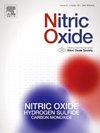Comprehensive evaluation of S-nitrosoglutathione and S-nitroso-N-acetylpenicillamine stability in biomedical contexts
IF 3.2
2区 生物学
Q2 BIOCHEMISTRY & MOLECULAR BIOLOGY
引用次数: 0
Abstract
Nitric oxide (NO) is a potent signaling molecule with great therapeutic potential. However, the clinical application of direct NO delivery is limited by its short half-life and high reactivity, which creates challenges for effective controlled delivery. To overcome these limitations, S-nitrosothiols (RSNOs) are commonly used as NO donors in therapeutic applications, as they stabilize the short-lived free radical and improve NO pharmacokinetics. Despite their widespread use, the stability and release kinetics of RSNOs under physiological conditions have not been thoroughly evaluated, which is crucial for determining their therapeutic efficacy and safety. This study provides a comprehensive evaluation of the stability and in vitro NO release profiles of two commonly used RSNOs, S-nitrosoglutathione (GSNO) and S-nitroso-N-acetylpenicillamine (SNAP), at physiologically relevant conditions. Using a range of analytical techniques, including electrospray ionization mass spectrometry, Griess assay, and electrochemical sensing, we assessed RSNO stability across various conditions, including different buffers, pH levels, temperatures, as well as exposure to UV light irradiation to simulate common sterilization practices. Additionally, we investigated RSNO stability in cell culture media with varying glucose levels and serum compositions to better mimic biological environments. Our findings provide critical insights into the factors affecting RSNO stability and NO release, advancing the development of more effective NO-based therapies and biomedical devices.
s -亚硝基谷胱甘肽和s -亚硝基-n -乙酰青霉胺在生物医学领域稳定性的综合评价。
一氧化氮(NO)是一种有效的信号分子,具有很大的治疗潜力。然而,直接给药一氧化氮的临床应用受到半衰期短和高反应性的限制,这给有效的控制给药带来了挑战。为了克服这些限制,s -亚硝基硫醇(RSNOs)通常被用作治疗应用中的NO供体,因为它们稳定了短寿命的自由基并改善了NO的药代动力学。尽管RSNOs被广泛使用,但其在生理条件下的稳定性和释放动力学尚未得到全面评估,这对确定其治疗效果和安全性至关重要。本研究在生理相关条件下,对两种常用的RSNOs s -亚硝基谷胱甘肽(GSNO)和s -亚硝基-n -乙酰青霉胺(SNAP)的稳定性和体外NO释放谱进行了综合评价。使用一系列分析技术,包括电喷雾电离质谱法、Griess测定法和电化学传感,我们评估了RSNO在不同条件下的稳定性,包括不同的缓冲液、pH值、温度,以及暴露在紫外线照射下,以模拟常见的灭菌操作。此外,我们研究了RSNO在不同葡萄糖水平和血清成分的细胞培养基中的稳定性,以更好地模拟生物环境。我们的研究结果对影响一氧化氮稳定性和一氧化氮释放的因素提供了重要的见解,推动了更有效的一氧化氮治疗和生物医学设备的发展。
本文章由计算机程序翻译,如有差异,请以英文原文为准。
求助全文
约1分钟内获得全文
求助全文
来源期刊

Nitric oxide : biology and chemistry
生物-生化与分子生物学
CiteScore
7.50
自引率
7.70%
发文量
74
审稿时长
52 days
期刊介绍:
Nitric Oxide includes original research, methodology papers and reviews relating to nitric oxide and other gasotransmitters such as hydrogen sulfide and carbon monoxide. Special emphasis is placed on the biological chemistry, physiology, pharmacology, enzymology and pathological significance of these molecules in human health and disease. The journal also accepts manuscripts relating to plant and microbial studies involving these molecules.
 求助内容:
求助内容: 应助结果提醒方式:
应助结果提醒方式:


